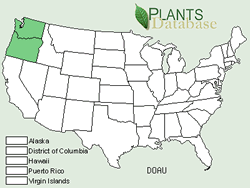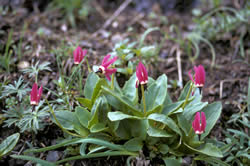Plant of the Week
 Range map of frigid shooting star. States are colored green where the species may be found.
Range map of frigid shooting star. States are colored green where the species may be found.
 Frigid shooting star (Dodecatheon austrofrigidum). Photo by Wilbur Bluhm, courtesy of Oregon Flora Project.
Frigid shooting star (Dodecatheon austrofrigidum). Photo by Wilbur Bluhm, courtesy of Oregon Flora Project.
Frigid Shooting Star (Dodecatheon austrofrigidum (Nutt. ex Hook. & Arn.) D. Dietr.)
By Forest Russell Holmes
Frigid shooting star is a member of the Primulaceae (Primrose family) which contains approximately 700 species primarily restricted to a north temperate distribution worldwide. Some species in the family are highly valued as ornamentals including Cyclamen, Primula (Primrose), Douglasia and Dodecatheon. Many of these attractive species have been over collected in the wild, some to the brink of extinction. The worldwide distribution of frigid shooting star is restricted to the coastal mountains of northwest Oregon and southwest Washington.
Frigid shooting star was discovered in 1945, but was not described until 1979. It is a perennial herb with stout fibrous roots that produce adventitious buds. Stems are 5.5 to 45 cm (2 to 18 inches) tall and leafless. Leaves arise from a basal rosette, are 2.5 to 30 cm (1 to 12 inches) long, egg shaped to elliptical and narrowing to a slender petiole. Leaf margins are smooth or toothed. The inflorescence produces 1 to 7 flowers. Petioles are 4 to 55 mm (3/16 to 2 inches). Flowers are lavender and the anthers are purple. Frigid shooting star can be easily confused with the few-flowered shooting star (Dodecatheon pulchellum). Frigid shooting star has filaments that are entirely separate while the few flowered shooting star has a fused filament tube at the base of the stamens.
The species grows on vernally moist basalt cliffs and steep slopes on thin soils near streams and waterfalls in open or shaded conditions. Elevation ranges from 30 to 1200 meters (100 to 4000 feet). Associated species include western hemlock (Tsuga hterophylla), Pacific silver fir (Abies amabilis), red alder (Alnus rubra), Nuttall’s saxifrage (Saxifraga nuttallii) and seep monkey flower (Mimulus guttatus).
For More Information
PLANTS Profile - Dodecatheon austrofrigidum, frigid shooting star

